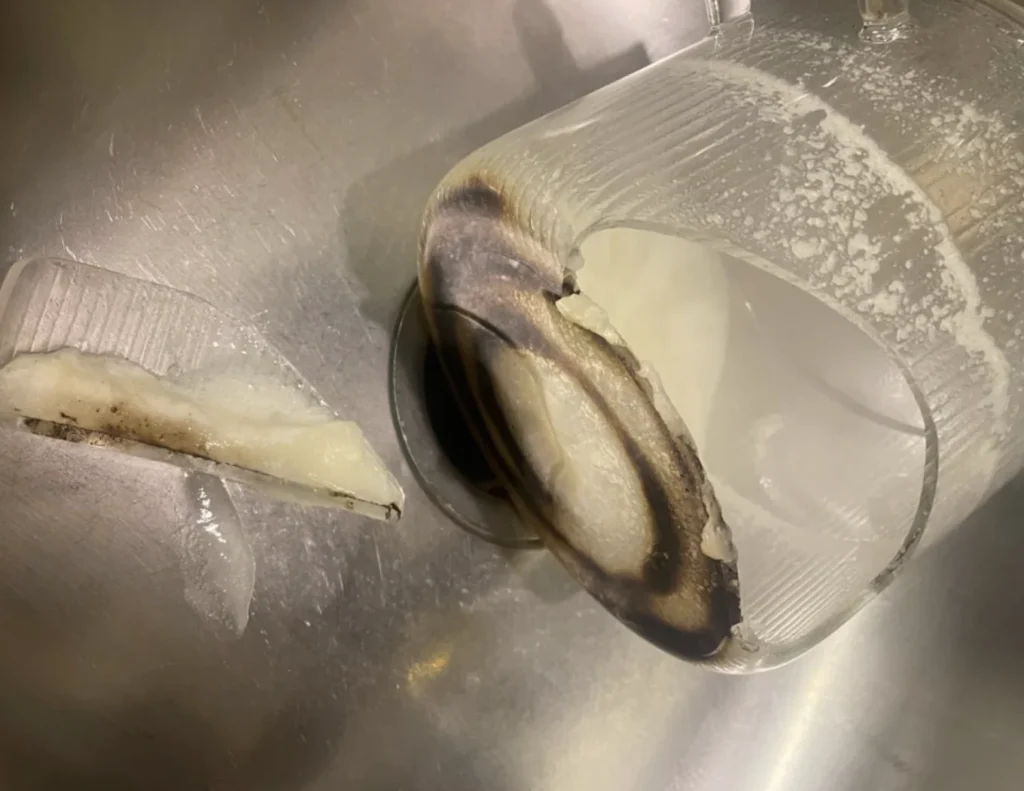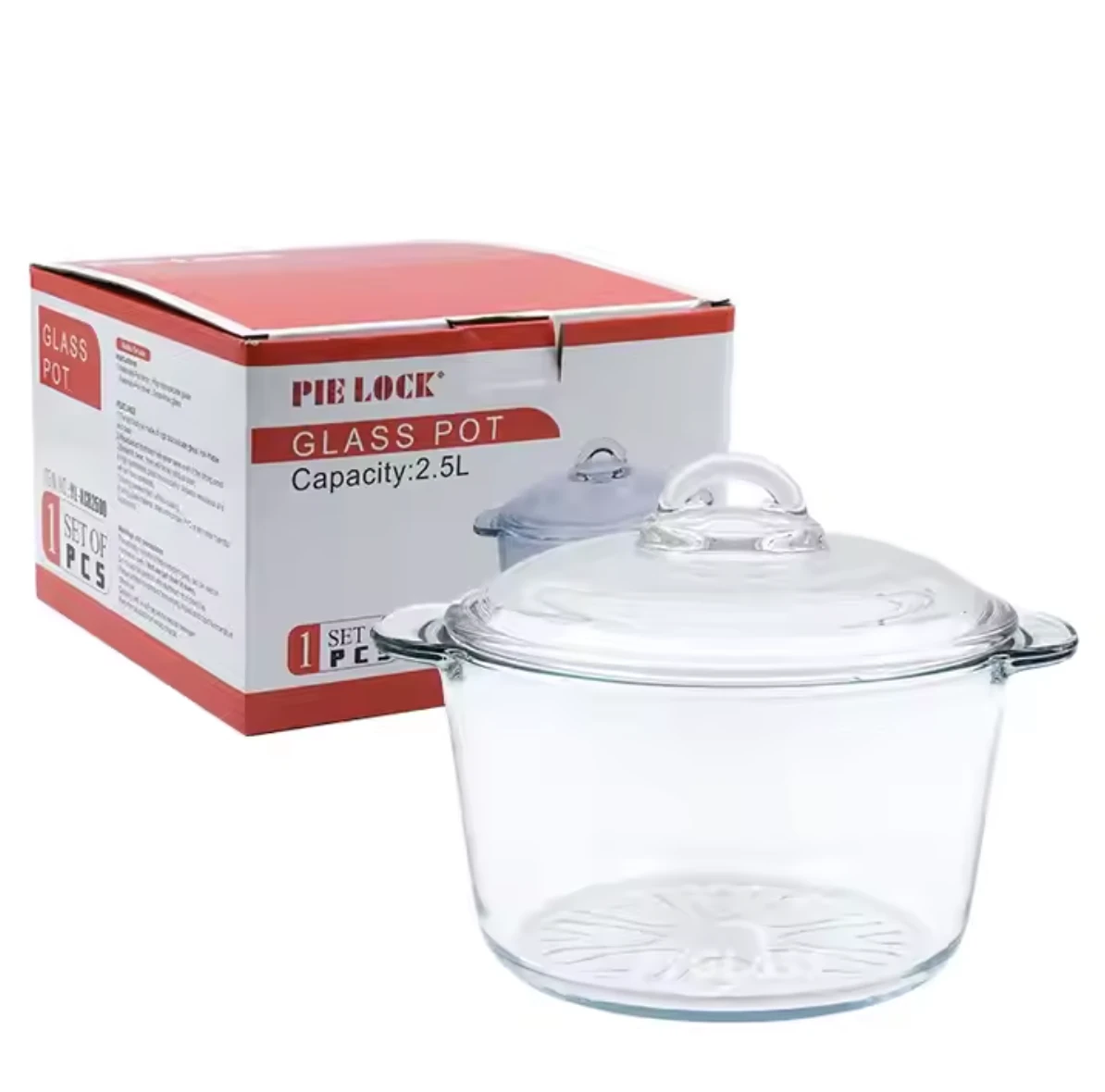Mucha gente ve la frase "olla de cristal resistente al calor" y asume que puede utilizarse directamente sobre una llama de gas. Pero un error y ¡bum! ¿Le suena?
Un recipiente de vidrio de borosilicato puede soportar el calentamiento con llama directa durante un corto periodo de tiempo, pero no está diseñado para una exposición prolongada a un quemador de gas. Si se utiliza mal, puede romperse.
Por ejemplo, esta reseña de Amazon: "Estaba hirviendo sémola y se me rompió la olla. Sémola caliente por todas partes. Era la segunda vez que la usaba. No estoy seguro de si esta olla sólo es segura para hervir agua o qué, pero definitivamente no quiero tratar de averiguarlo de nuevo."
Muchos clientes se hacen esta pregunta cuando buscan cristalería para cocinar. La respuesta no es complicada, pero a menudo se malinterpreta. Si usted es vendedor, entenderlo claramente reducirá las devoluciones y las críticas negativas. Vamos a explicarlo.
¿Por qué no se recomienda el vidrio de borosilicato para cocinar a fuego abierto? ¿En qué se diferencia de Corning Visions?
El vidrio de borosilicato es resistente al calor, pero no es adecuado para cocinar con llama directa. La línea Visions de Corning utiliza un material completamente distinto llamado pirocerámica (vitrocerámica).
Si ambas son ollas de cristal, ¿por qué una sobrevive a las llamas y la otra no?
Aunque el vidrio de borosilicato tolera altas temperaturas, su resistencia al choque térmico es muy inferior a la de la pirocerámica. Son materiales fundamentalmente diferentes.
Principales diferencias entre los dos materiales:
| Elemento de comparación | Vidrio borosilicato | Pirocerámica vitrocerámica |
|---|---|---|
| Estructura material | Vidrio amorfo | Vitrocerámica microcristalina |
| Ingredientes principales | SiO₂, B₂O₃, Na₂O, Al₂O₃. | SiO₂, Al₂O₃, Li₂O, TiO₂, MgO |
| Expansión térmica | 3.3 × 10-⁶ /℃ | 0 ~ 1 × 10-⁶ /℃ (extremadamente bajo) |
| Choque térmico | 350~500°C | Hasta 600~800°C |
| Resistencia máxima al calor | Alrededor de 500°C | 700~800°C |
| Uso directo de la llama | ❌ No recomendado (riesgo de reventón) | ✅ Seguro para llama abierta |
| Transparencia | Muy alta | Moderado, a menudo de color ámbar/oscuro |
| Conductividad térmica | Bajo | Moderado e incluso |
| Apto para microondas | ✅ Sí | ✅ Sí |
| Apto para horno | ✅ Sí | ✅ Sí |
| Estufa de inducción | ❌ A menos que se añada una base metálica | ✅ Algunos modelos |
| Apto para congelador | ✅ Sí | ✅ Sí |
| Resistencia a la corrosión | Fuerte | Extremadamente fuerte |
| Coste | Moderado | Alta (compleja de producir) |
| Marcas populares | PYGLASS, LocknLock, BoroGlass | Corning Visions (patentado) |
La línea Visions de Corning utiliza pirocerámica, una vitrocerámica que parece transparente pero se comporta como cerámica. Se puede sacar de la nevera y colocarlo sobre una llama directa sin que se rompa. El borosilicato, sin embargo, se agrieta con semejante choque térmico.
Así que cuando comercialice o ponga en el mercado un bote de vidrio de borosilicato, debe indicar claramente: puede soportar el uso de la llama a corto plazo (por ejemplo, hervir sopa a fuego lento), pero NO es para cocinar a fuego abierto durante mucho tiempo.
¿Cómo pueden saber los clientes si un tarro de cristal es ignífugo?
La mayoría de los compradores no pueden identificar los tipos de vidrio con sólo mirarlos. Por ello, el etiquetado y la orientación del vendedor son fundamentales.
Sugerimos a los vendedores que incluyan instrucciones de uso claras en la página del producto y en el envase:
"Se trata de una olla de vidrio de borosilicato, apta para microondas y calentamiento con llama abierta a corto plazo. No calentar en seco ni usar en cocina de inducción".
Incluye detalles como: Olla de vidrio de borosilicato de 3,3 coeficientes, no un producto de vitrocerámica.
Esto reduce el uso indebido, evita comentarios negativos y demuestra su profesionalidad.
Cómo pueden los vendedores reducir los daños y las devoluciones
Con el etiquetado, las instrucciones y el envasado adecuados, pueden evitarse la mayoría de los problemas.
Los vendedores primerizos de ollas de cristal suelen temer más una cosa: críticas como "¡Ha explotado!". "¡Se rompió en la cocina!" "¡Se rompió después de dos usos!" Suena aterrador, pero hay soluciones.
Estos son nuestros consejos probados para minimizar el riesgo:
1. Marque claramente los límites de uso en títulos e imágenes
En Amazon o en su sitio DTC, utilice iconos como:
- ✅ Microondas ✔️ Horno ✔️ Cocina de gas (llama baja) ✔️
- ❌ Inducción × Quemado en seco × Rehogado × Salteado
También puede introducir una tarjeta de consejos dentro de la caja para reforzar el uso seguro.
2. Utilizar envases protectores y estructurados
Cuando empaquete utensilios de cocina de cristal, separe siempre la olla y la tapa con bandejas de espuma a medida. Evite el movimiento. Utilice cajas exteriores de cartón ondulado de 5 capas con protección en las esquinas.
Uno de nuestros clientes añadió una película de burbujas de aire entre la tapa y la olla. Un pequeño coste = mejores críticas.
3. Ofrecer un servicio de atención al cliente proactivo
No espere a recibir quejas. Sea claro desde el principio:
- Añadir etiquetas "Frágil - Cristalería" en las páginas de productos;
- Ofrecer políticas de sustitución/reembolso gratuitas;
- Supervise las reseñas y siga mejorando la claridad de los anuncios.
4. Proporcionar servicios completos de personalización
Ayudamos a los vendedores prueba de mercado rápido con:
- 🔹 Impresión de logotipos personalizados en vidrio
- 🔹 Diseños de envases listos para la venta al por menor
- 🔹 MOQs bajos (a partir de 500 juegos)
Los vendedores independientes de Estados Unidos y Australia nos lo dicen: cuanto más completa es la presentación, mayores son las conversiones.
Y a la hora de elegir marcas de utensilios de cocina de vidrio borosilicato, asegúrese de que su proveedor tiene experiencia en exportación, certificaciones de conformidad y una gran capacidad de personalización.
FAQ: Uso de ollas de vidrio borosilicato en cocinas de gas
1. ¿Las ollas de vidrio borosilicato pueden utilizarse directamente en una cocina de gas?
Sí, pero sólo para calefacción de corta duración y baja llama. El vidrio de borosilicato es resistente al calor, pero no está diseñado para un uso prolongado o a altas temperaturas con llama abierta. Evite calentar en seco o sofreír.
2. ¿Qué ocurre si se utiliza a fuego alto o durante periodos prolongados?
La olla puede agrietarse o romperse por choque térmico. El vidrio de borosilicato suele resistir choques térmicos de hasta 350-500°C. La exposición directa y prolongada a las llamas puede superar fácilmente este límite.
3. ¿En qué se diferencia de la batería de cocina Corning Visions?
Corning Visions utiliza Pirocerámica (vitrocerámica)que tiene una resistencia al choque térmico significativamente mayor (hasta 800°C). A diferencia del vidrio de borosilicato, puede pasar del congelador a la llama.
4. ¿Se pueden utilizar recipientes de vidrio borosilicato en las placas de inducción?
No, a menos que el fondo esté modificado con una capa metálica. La mayoría de los utensilios de cocina de vidrio de borosilicato son no compatible con placas de inducción.
5. ¿Es seguro para su uso en hornos microondas, hornos convencionales y congeladores?
✅ Sí. La batería de cocina de vidrio borosilicato es apta para microondas, horno y congelador. Sólo hay que evitar los cambios bruscos de temperatura extrema.
Conclusión
Macetas de vidrio borosilicato puede soportar llamas abiertas a corto plazopero no de cocina extendida. Asegúrese de que sus compradores lo sepan. Una descripción clara del producto, un embalaje adecuado y un servicio proactivo ayudan a evitar devoluciones y malas críticas.
Mi papel
Quiénes somos
Marca: PYGLASS
Eslogan: Fabricado para cocinar. Listo para la marca.
Página web: www.slyprc.com
Nuestra misión:
PYGLASS se especializa en utensilios de cocina de vidrio borosilicato, con 15 años de experiencia en exportación. Apoyamos OEM/ODM, ofrecemos soluciones completas de embalaje y ayudamos a los vendedores a tener éxito con cristalería para cocinar lista para enviar.


